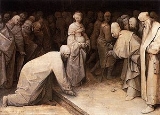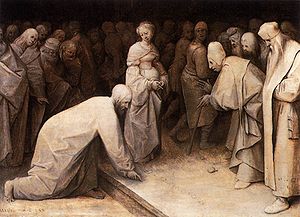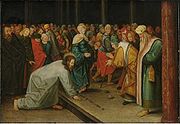
Christ and the Woman Taken in Adultery
Encyclopedia

Panel painting
A panel painting is a painting made on a flat panel made of wood, either a single piece, or a number of pieces joined together. Until canvas became the more popular support medium in the 16th century, it was the normal form of support for a painting not on a wall or vellum, which was used for...
in grisaille
Grisaille
Grisaille is a term for painting executed entirely in monochrome or near-monochrome, usually in shades of grey. It is particularly used in large decorative schemes in imitation of sculpture. Many grisailles in fact include a slightly wider colour range, like the Andrea del Sarto fresco...
(near monochrome) by the Netherlandish Renaissance
Dutch and Flemish Renaissance painting
Dutch and Flemish Renaissance painting represents the 16th century response to Italian Renaissance art in the Low Countries. These artists, who span from the Antwerp Mannerists and Hieronymus Bosch at the start of the century to the late Northern Mannerists such as Hendrik Goltzius and Joachim...
printmaker and painter Pieter Bruegel the Elder (1525 - 1569). It is signed and dated 1565.
Jesus and the woman taken in adultery is a biblical episode from where Jesus
Jesus
Jesus of Nazareth , commonly referred to as Jesus Christ or simply as Jesus or Christ, is the central figure of Christianity...
encounters an adulteress brought before Pharisees
Pharisees
The Pharisees were at various times a political party, a social movement, and a school of thought among Jews during the Second Temple period beginning under the Hasmonean dynasty in the wake of...
and scribes
Scribes
Scribes is a minimalist and extensible text editor for GNOME that combines simplicity with power. Scribes focuses on ways workflow and productivity can be intelligently automated and radically improved...
, which has been depicted by many artists. Such a crime was punishable by death by stoning
Stoning
Stoning, or lapidation, is a form of capital punishment whereby a group throws stones at a person until the person dies. No individual among the group can be identified as the one who kills the subject, yet everyone involved plainly bears some degree of moral culpability. This is in contrast to the...
, however, in the scene, Jesus stoops to write (in Dutch) "he that is without sin among you, let him first cast the stone at her" on the ground before her feet. A number of the unthrown stones lay on the floor to the left of the woman.
Bruegel depicts the woman as one of the few graceful figures in the scene. She is rendered as an idealised form, atypical of Brugel's usual earthy and homely female figures; though the basic layout of the composition is Netherlandish, "the austere composition and monumental figures are perhaps the most Italianate in all Bruegel's paintings".
The painting was not sold by the artist, and seems to be the only one inherited by his son Jan Brueghel the Elder
Jan Brueghel the Elder
Jan Brueghel the Elder was a Flemish painter, son of Pieter Bruegel the Elder and father of Jan Brueghel the Younger. Nicknamed "Velvet" Brueghel, "Flower" Brueghel, and "Paradise" Brueghel, of which the latter two were derived from his floral still lifes which were his favored subjects, while the...
. An engraving
Engraving
Engraving is the practice of incising a design on to a hard, usually flat surface, by cutting grooves into it. The result may be a decorated object in itself, as when silver, gold, steel, or glass are engraved, or may provide an intaglio printing plate, of copper or another metal, for printing...
was published in 1579 by Paul Perret, who was apparently lent the painting for the purpose, since there are regular pricks along the edges to enable a grid to be made. There are a number of other copies, some attributed to the artist's sons, perhaps made after the engraving, and the painting was lent to Cardinal Federico Borromeo
Federico Borromeo
Federico Borromeo was an Italian ecclesiastic, cardinal and archbishop of Milan.-Biography:Federico Borromeo was born in Milan as the second son of Giulio Cesare Borromeo, Count of Arona, and Margherita Trivulzio...
for copying (perhaps the version now in Bergamo
Bergamo
Bergamo is a town and comune in Lombardy, Italy, about 40 km northeast of Milan. The comune is home to over 120,000 inhabitants. It is served by the Orio al Serio Airport, which also serves the Province of Bergamo, and to a lesser extent the metropolitan area of Milan...
). A version attributed to Breuegel's son Pieter Brueghel the Younger
Pieter Brueghel the Younger
Pieter Brueghel the Younger /ˈpitəɾ ˈbɾøːxəl/ was a Flemish painter, known for numerous copies after his father Pieter Brueghel the Elder's paintings and nicknamed "Hell Brueghel" for his fantastic treatments of fire and grotesque imagery.-Life:Pieter Brueghel the Younger was the oldest son of the...
of c. 1600 is in the Philadelphia Museum of Art
Philadelphia Museum of Art
The Philadelphia Museum of Art is among the largest art museums in the United States. It is located at the west end of the Benjamin Franklin Parkway in Philadelphia's Fairmount Park. The Museum was established in 1876 in conjunction with the Centennial Exposition of the same year...
.

Jan Brueghel the Younger
Jan Brueghel the Younger was a Flemish Baroque painter, and the son of Jan Brueghel the Elder.He was trained by his father and spent his career producing works in a similar style. Along with his brother Ambrosius, he produced landscapes, allegorical scenes and other works of meticulous detail. ...
, and was in England by the 18th century, being sold at Christie's
Christie's
Christie's is an art business and a fine arts auction house.- History :The official company literature states that founder James Christie conducted the first sale in London, England, on 5 December 1766, and the earliest auction catalogue the company retains is from December 1766...
in 1834 and again in 1952 when it was bought by Count Antoine Seilern, whose collection was bequeathed to the Courtauld in 1978. The work was stolen from the Courtauld Gallery on 2 February 1982. Because of its value and fame, it proved unsaleable on the open market, and did not resurface again until 1992 when it was recovered by British police. During that interim, it likely acted as collateral for the criminals.
Sources
- Braham Helen, The Princes Gate Collection, Courtauld Institute Galleries, London 1981, ISBN 0904563049
- Hagen, Rose-Marie & Hagen, Rainer. Bruegel. Peasants, Fools and Demons. Taschen, 2000. ISBN 3-8228-5991-5
- Sutton, Peter. Dutch and Flemish Paintings: The Collection of Willem, Baron Van Dedem. Frances Lincoln, 2002. ISBN 0-7112-2010-7

